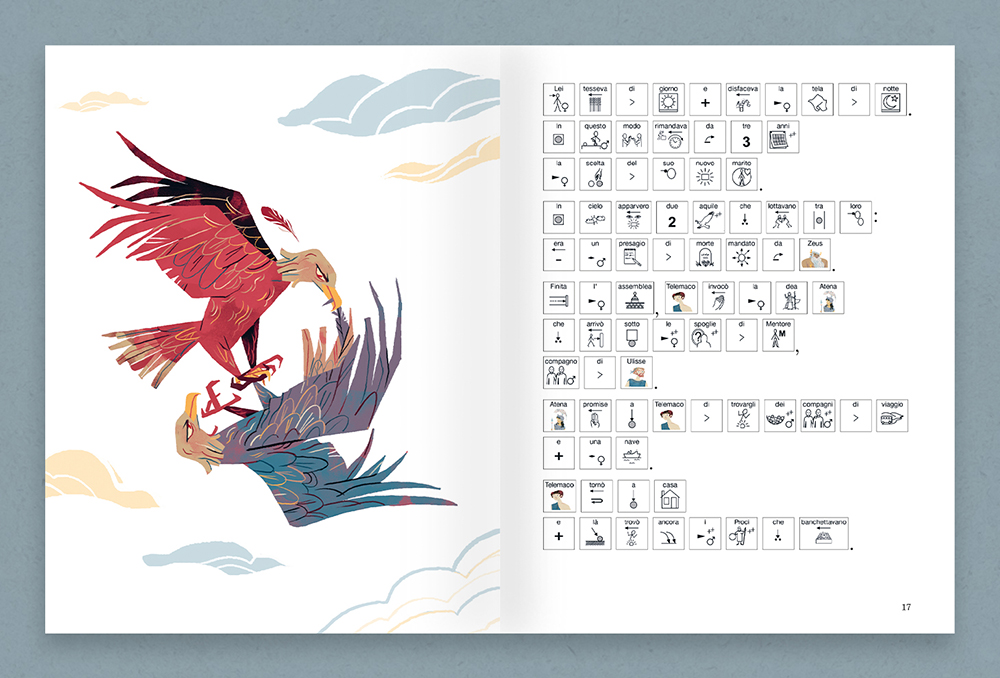 EN
EN
 PT
PT
Product: Book
Trim size in cm: 24x31cm
Pages: 148
ISBN: 9788859027577
Publication date: 01/01/2022
Suitable for: Lower secondary 1st level (ages 10-11), Lower secondary 2nd level (ages 12-13)
REQUEST A SAMPLE OR MORE INFORMATION
Ulysses’ return journey to Ithaca, after the Trojan war, is the common thread of Homer’s great poem, amidst dangers, shipwrecks, monsters, tricks and spells. In addition to Ulysses / Odysseus, his wife Penelope, his son Telemachus, the sorceress Circe, the cyclops Polyphemus and the suitors are among the unforgettable protagonists of this masterpiece of the epic genre. The story is offered in an inbook version, or in an illustrated book, based on the text of the Easy Classics series, written entirely with the symbols of Augmentative and Alternative Communication. A literary classic that kids can read, share and even listen to, as an audio book.
Index
Chapter 1 - The council of the gods
Chapter 2 - Telemachus visits Nestor and Menelaus
Chapter 3 - Ulysses on the island of the Phaeacians
Chapter 4 - The adventure of the Cyclops
Chapter 5 - The adventure of Aeolus
Chapter 6 - The Sirens
Chapter 7 - Ulysses and Telemachus meet
Chapter 8 - Ulysses returns to his palace
Chapter 9 - Ulysses’ revenge
Chapter 10 - Peace comes to Ithaca

The Classics with AAC are the inbook versions of Easy Classics by Carlo Scataglini.
Inbooks come from the need to facilitate ways of listening to audio versions of illustrated books. They are aimed mainly at children and youths with communication problems but can be used, starting with the «Born to read» experiences, by all children.
Particular attention is given to the narrative quality: the words and the emotions that are stirred within us with the narration help us not only put ourselves in others' shoes but they are also an essential step in the creation of thoughts and, over time, of narratives too, thus strengthening relationships and learning. When such a pleasurable and important experience is lacking or is limited, we lose precious sustenance for our hearts and minds.

Moving from inbook versions of illustrated books for nursery-aged children to inbook versions of books for older children or even of the classics is not an easy feat. The risk of falling into the trap of trivialising or simplifying too much to the detriment of the original narrative strength is high. The Easy Classics by Carlo Scataglini are an important bridge. They are linear but they maintain integrity and energy; they are simple yet rich at the same time. This mediation guarantees both easy reading and the opportunity of translation into faithful symbols and a rich vocabulary which renders inbooks capable of thrilling youngsters of all ages.
WHAT IS AUGMENTATIVE AND ALTERNATIVE COMMUNICATION?
Augmentative and Alternative Communication (AAC) is «an area of clinical practice which aims to compensate temporary and permanent disabilities of people with complex communicative needs» (ASHA, 2005). The adjective «Augmentative» is not meant to suggest a substitution for natural communication but a way of augmenting it by using all the individual's competences, including vocalisations or existing verbal language, gestures, signs and communication with aids and advanced technology.
These books are inbooks
It is a book translated into symbols, which comes from the need to facilitate ways of listening to audio versions of illustrated books for children and youths. The inbook model is edited by Centro Studi Inbook csinbook.eu, which ensures consistency and its development. It has the following characteristics:

In this way the symbol is associated to the word that is read aloud and those listening can follow the text more easily.